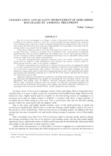Hay has several advantages over silages in terms of the preservation, transportation and handling of the products. However, there are various problems in hay-making in the monsoon zone including Japan, since the weather conditions during the harvesting period of hay crop are unfavorable and characterized by rain and a high humidity level especially, at the time of the 1st cutting which is associated with the highest yield.
Under these conditions, almost all of the field-cured hay would be too wet to be baled for storage. When hay is baled at a moisture level exceeding 20-25%, mold growth is promoted, generating heat that can reduce significantly the feeding value. On the other hand, hay baled at too low a moisture content is subject to mechanical shattering of leaves and slender stems, which results in a high loss of dry matter and nutrients.
It has been recongnized that anhydrous ammonia (NH3) was rapidly absorbed by moist tissues and was lethal to mold. Furthermore, this substance has shown a positive effect in improving the nutritive value of low quality roughages.
Therefore, experiments were carried out to evaluate the preservation of roughage hay baled at 25 to 40% moisture level by the application of anhydrous ammonia. Ammoniation was carried out in the field in applying the stack method. The bales with semi-dried roughage hay were stacked in a sunny place, and covered with a transparent plastic sheet. The materials were sealed and injected with anhydrous ammonia at 3 to 4% (W /W) of dry matter, and then left for above one week before use as feed.
Ammonia treatment prevented the occurrence of molding and heating of semi-dried stored hay, and improved significantly hay quality by increasing the total nitrogen content, cell wall digestibility and feeding value. In addition, ammonia treatment destroyed weed seeds and Fasciola eggs. Ammonia treatment does not require an elaborate processing equipment to incorporate and to distribute the reagents evenly unlike other alkali treatments. Therefore, it is anticipated that the present method will be readily adopted by many farmers.

